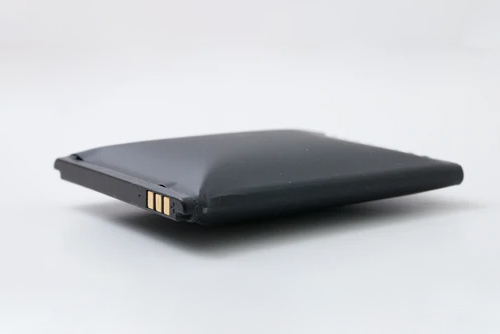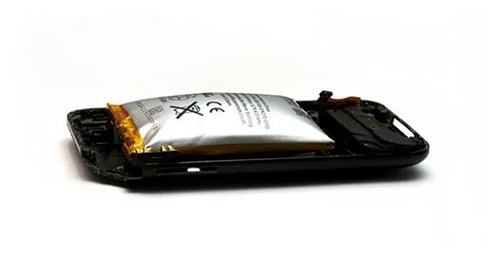Анализ причин вздутия и взрыва литиевых аккумуляторов

Принцип работы литий-ионных аккумуляторов
Литий — самый маленький и самый активный металл в химической периодической таблице. Он популярен среди потребителей и инженеров из-за своего небольшого размера и высокой плотности емкости. Однако его химические свойства слишком активны, что несет чрезвычайно высокую опасность. Когда металлический литий подвергается воздействию воздуха, он производит бурную реакцию окисления с кислородом и взрывается. Чтобы повысить безопасность и напряжение, ученые изобрели такие материалы, как графит и оксид лития-кобальта для хранения атомов лития. Молекулярная структура этих материалов образует крошечные наномасштабные сетки хранения, которые можно использовать для хранения атомов лития. Таким образом, даже если оболочка батареи сломана и проникает кислород, молекулы кислорода слишком велики, чтобы войти в эти крошечные сетки хранения, так что атомы лития не вступят в контакт с кислородом и избегут взрыва. Этот принцип литий-ионных батарей позволяет людям достичь безопасности, получая при этом высокую плотность емкости.
Литий — самый маленький и самый активный металл в химической периодической таблице. Он популярен среди потребителей и инженеров из-за своего небольшого размера и высокой плотности емкости. Однако его химические свойства слишком активны, что несет чрезвычайно высокую опасность. Когда металлический литий подвергается воздействию воздуха, он производит бурную реакцию окисления с кислородом и взрывается. Чтобы повысить безопасность и напряжение, ученые изобрели такие материалы, как графит и оксид лития-кобальта для хранения атомов лития. Молекулярная структура этих материалов образует крошечные наномасштабные сетки хранения, которые можно использовать для хранения атомов лития. Таким образом, даже если оболочка батареи сломана и проникает кислород, молекулы кислорода слишком велики, чтобы войти в эти крошечные сетки хранения, так что атомы лития не вступят в контакт с кислородом и избегут взрыва. Этот принцип литий-ионных батарей позволяет людям достичь безопасности, получая при этом высокую плотность емкости.
Когда литий-ионная батарея заряжается, атомы лития в положительном электроде теряют электроны и окисляются до ионов лития. Ионы лития перемещаются к отрицательному электроду через электролит, попадают в ячейку хранения отрицательного электрода и получают электрон, который восстанавливается до атомов лития. При разрядке весь процесс происходит в обратном порядке. Чтобы предотвратить прямое соприкосновение и короткое замыкание положительных и отрицательных электродов батареи, в батарею добавляется мембранная бумага с большим количеством пор, чтобы предотвратить короткое замыкание. Хорошая мембранная бумага также может автоматически закрывать поры, когда температура батареи слишком высока, так что ионы лития не могут пройти и предотвратить опасность.
♦ Меры защиты ♦
Когда литиевая батарея перезаряжается до напряжения выше 4,2 В, начинают проявляться побочные эффекты. Чем выше напряжение перезаряда, тем выше опасность. Когда напряжение литиевой батареи выше 4,2 В, количество атомов лития, оставшихся в материале положительного электрода, составляет менее половины, и в это время ячейка хранения часто разрушается, что приводит к постоянному снижению емкости батареи. Если зарядка продолжается, поскольку ячейка хранения отрицательного электрода уже заполнена атомами лития, последующий металлический литий будет накапливаться на поверхности материала отрицательного электрода. Эти атомы лития будут расти в виде дендритов от поверхности отрицательного электрода к ионам лития. Эти кристаллы металлического лития будут проходить через мембранную бумагу, вызывая короткое замыкание положительного и отрицательного электродов. Иногда батарея взрывается до того, как произойдет короткое замыкание. Это происходит потому, что во время процесса перезаряда электролит и другие материалы будут разлагаться с выделением газа, в результате чего оболочка батареи или клапан давления разбухают и разрываются, позволяя кислороду проникать и реагировать с атомами лития, накопленными на поверхности отрицательного электрода, а затем взрываться. Поэтому при зарядке литиевых аккумуляторов необходимо установить верхний предел напряжения, чтобы одновременно учитывать срок службы аккумулятора, его емкость и безопасность. Наиболее идеальный верхний предел напряжения зарядки составляет 4,2 В.
Также существует нижний предел напряжения при разрядке литиевых батарей. Когда напряжение батареи ниже 2,4 В, некоторые материалы начнут повреждаться. Поскольку батарея будет саморазряжаться, чем дольше она разряжается, тем ниже будет напряжение. Поэтому лучше не прекращать разрядку при 2,4 В. В период, когда литиевая батарея разряжается с 3,0 В до 2,4 В, высвобождаемая энергия составляет всего около 3% от емкости батареи. Поэтому 3,0 В является идеальным напряжением отключения разрядки.
При зарядке и разрядке, помимо ограничения напряжения, необходимо также ограничение тока. Когда ток слишком большой, ионы лития не успеют попасть в ячейку хранения и будут собираться на поверхности материала. После того, как эти ионы лития получат электроны, атомы лития кристаллизуются на поверхности материала, что так же опасно, как и перезарядка. Если оболочка батареи сломается, она взорвется.
Поэтому защита литий-ионных аккумуляторов должна как минимум включать: верхний предел зарядного напряжения, нижний предел разрядного напряжения и верхний предел тока.
В общем, в дополнение к литиевой ячейке аккумулятора в литиевой аккумуляторной батарее будет защитная плата, которая в основном обеспечивает эти три защиты. Однако этих трех защит защитной платы явно недостаточно, и взрывы литиевых аккумуляторов по-прежнему часты во всем мире. Для обеспечения безопасности аккумуляторной системы необходим более тщательный анализ причин взрывов аккумуляторов.

♦ Причины взрыва аккумулятора ♦
- Большая внутренняя поляризация!
- Полюсный наконечник впитывает воду и вступает в реакцию с электролитом, вызывая вздутие воздуха.
- Качество и производительность самого электролита.
- Количество жидкости, впрыскиваемой при впрыскивании, не соответствует технологическим требованиям.
- Герметичность лазерной сварки в процессе сборки низкая, утечки воздуха и их обнаружение невозможны.
- Пыль, пыль на полюсном наконечнике, в первую очередь подвержена микрокоротким замыканиям, конкретная причина которых неизвестна.
- Положительные и отрицательные полюсные наконечники толще, чем рабочий диапазон, что затрудняет их проникновение в оболочку.
- Проблемы с герметизацией при впрыске жидкости, плохая герметизация стальных шариков приводит к образованию пузырьков воздуха.
- Стенка оболочки из материала оболочки слишком толстая, и деформация оболочки влияет на толщину.
♦ Анализ типа взрыва ♦
Типы взрывов ядра батареи можно обобщить как внешние короткие замыкания, внутренние короткие замыкания и перезаряд. Под внешним здесь понимается внешняя часть ячейки батареи, включая короткие замыкания, вызванные плохой конструкцией изоляции внутри аккумуляторной батареи.
Когда короткое замыкание происходит снаружи ячейки батареи, и электронные компоненты не могут отключить цепь, внутри ячейки батареи будет генерироваться большое количество тепла, что приведет к испарению части электролита и расширению оболочки батареи. Когда температура внутри батареи достигнет 135 градусов Цельсия, качественная мембранная бумага закроет поры, электрохимическая реакция прекратится или почти прекратится, ток резко упадет, а температура будет медленно падать, тем самым предотвращая взрыв. Однако, если скорость закрытия пор слишком низкая или поры мембранной бумаги вообще не закрыты, температура батареи будет продолжать расти, больше электролита будет испаряться, и, в конце концов, оболочка батареи будет разрушена, и даже температура батареи повысится до точки, где материал сгорит и взорвется.
Внутренние короткие замыкания в основном вызваны заусенцами на медной и алюминиевой фольге, проникающими в диафрагму, или дендритами атомов лития, проникающими в диафрагму. Эти крошечные игольчатые металлы будут вызывать микрокороткие замыкания. Поскольку иглы очень тонкие и имеют определенное значение сопротивления, ток может быть не очень большим. Заусенцы на медной и алюминиевой фольге возникают в процессе производства. Наблюдаемое явление заключается в том, что батарея слишком быстро протекает, и большинство из них могут быть отсеяны на заводе по производству аккумуляторных элементов или на сборочном заводе. Более того, поскольку заусенцы малы, они иногда могут сгореть, так что батарея возвращается в нормальное состояние. Поэтому вероятность взрыва, вызванного микрокоротким замыканием из-за заусенцев, невелика.
Это утверждение может быть статистически подтверждено тем фактом, что на каждом заводе по производству аккумуляторов часто встречаются плохие батареи с низким напряжением вскоре после зарядки, но взрывов происходит мало. Поэтому взрыв, вызванный внутренним коротким замыканием, в основном вызван перезарядкой. Поскольку после перезарядки электрод заполнен игольчатыми кристаллами лития, точки прокалывания находятся повсюду, и микрокороткие замыкания происходят повсюду. Поэтому температура батареи будет постепенно повышаться, и в конечном итоге высокая температура приведет к газификации электролита. В этом случае, будь то слишком высокая температура, чтобы вызвать возгорание и взрыв материала, или оболочка сначала сломается, позволяя воздуху проникнуть и бурно окислиться с литием, это закончится взрывом.
Однако этот взрыв, вызванный внутренним коротким замыканием, вызванным перезарядкой, не обязательно происходит во время зарядки. Возможно, температура батареи недостаточно высока, чтобы вызвать возгорание материала, а выделяющегося газа недостаточно, чтобы сломать оболочку батареи, и потребитель прекращает зарядку и достает мобильный телефон. В это время тепло, выделяемое многочисленными микрокороткими замыканиями, медленно повышает температуру батареи, и через некоторое время происходит взрыв. Потребители часто описывают, что они находят свои телефоны очень горячими, когда берут их в руки, и они взрываются, когда выбрасывают их.
На основе вышеперечисленных типов взрывов мы можем сосредоточиться на трех аспектах предотвращения взрывов: предотвращение перезаряда, предотвращение внешних коротких замыканий и повышение безопасности элементов батареи. Среди них предотвращение перезаряда и предотвращение внешних коротких замыканий относятся к электронной защите, которая тесно связана с конструкцией системы батареи и сборкой батареи. Ключом к повышению безопасности элементов батареи является химическая и механическая защита, которая тесно связана с производителями элементов батареи.
♦ Технические характеристики конструкции ♦
Поскольку в мире сотни миллионов мобильных телефонов, для обеспечения безопасности частота отказов защитной защиты должна быть менее одного на 100 миллионов. Поскольку частота отказов печатных плат, как правило, намного выше, чем один на 100 миллионов. Поэтому при проектировании аккумуляторной системы должно быть более двух линий защиты безопасности. Распространенной ошибкой проектирования является использование зарядного устройства (адаптера) для непосредственной зарядки аккумуляторной батареи. Таким образом, ответственность за защиту от перезарядки полностью передается плате защиты на аккумуляторной батарее. Хотя частота отказов платы защиты невелика, даже если частота отказов составляет всего один на миллион, все равно существует вероятность того, что несчастные случаи со взрывами будут происходить каждый день по всему миру.
Если система аккумулятора может обеспечить две защиты безопасности для перезаряда, переразряда и перегрузки по току, соответственно, если частота отказов каждой защиты составляет один на десять тысяч, две защиты могут снизить частоту отказов до одного на 100 миллионов. Ниже приведена структурная схема обычной системы зарядки аккумулятора, которая включает в себя две основные части: зарядное устройство и аккумуляторный блок. Зарядное устройство также включает в себя две части: адаптер (адаптер) и контроллер зарядки. Адаптер преобразует переменный ток в постоянный ток, а контроллер зарядки ограничивает максимальный ток и максимальное напряжение постоянного тока. Аккумуляторный блок состоит из двух частей: платы защиты и аккумуляторного элемента, а также PTC для ограничения максимального тока.
Если взять в качестве примера систему аккумулятора мобильного телефона, то система защиты от перезаряда использует выходное напряжение зарядного устройства, установленное на уровне около 4,2 В, для достижения первого уровня защиты. Таким образом, даже если плата защиты на аккумуляторе выйдет из строя, аккумулятор не будет перезаряжен и не станет опасным. Вторая линия защиты — это функция защиты от перезаряда на плате защиты, которая обычно установлена на 4,3 В. Таким образом, плата защиты не должна отвечать за отключение зарядного тока. Она должна действовать только тогда, когда напряжение зарядного устройства ненормально высокое. Защита от перегрузки по току — это ответственность платы защиты и ограничителя тока, которые также являются двумя линиями защиты для предотвращения перегрузки по току и внешнего короткого замыкания. Поскольку переразряд происходит только во время использования электронных продуктов. Поэтому общая конструкция заключается в том, что печатная плата электронного продукта обеспечивает первую защиту, а плата защиты на аккумуляторе обеспечивает вторую защиту. Когда электронный продукт обнаруживает, что напряжение питания ниже 3,0 В, он должен автоматически отключиться. Если эта функция не предусмотрена при проектировании изделия, плата защиты замкнет цепь разряда, когда напряжение опустится до 2,4 В.
Короче говоря, при проектировании системы аккумулятора необходимо предусмотреть две электронные защиты: от перезаряда, переразряда и перегрузки по току. Защитная плата — это вторая защита. Если аккумулятор взрывается при снятии защитной платы, это означает, что конструкция плохая.
Хотя вышеописанный метод обеспечивает две защиты, потребители часто покупают неоригинальные зарядные устройства для зарядки после поломки зарядного устройства, а производители зарядных устройств часто удаляют контроллер зарядки, чтобы сократить расходы, исходя из соображений стоимости. В результате плохие деньги вытесняют хорошие деньги, и на рынке появляется много некачественных зарядных устройств. Это делает защиту от перезарядки лишённой первой и самой важной линии обороны. Перезарядка является наиболее важным фактором, вызывающим взрывы аккумуляторов, поэтому некачественные зарядные устройства можно считать виновниками взрывов аккумуляторов.
♦ |35| ♦
|36|
|37|
|38||39||40|
- |41|
- |42|
- |43|
- |44|
- |45|
- |46|
- |47|
- |48|
- |49|
- |50|
|51|








